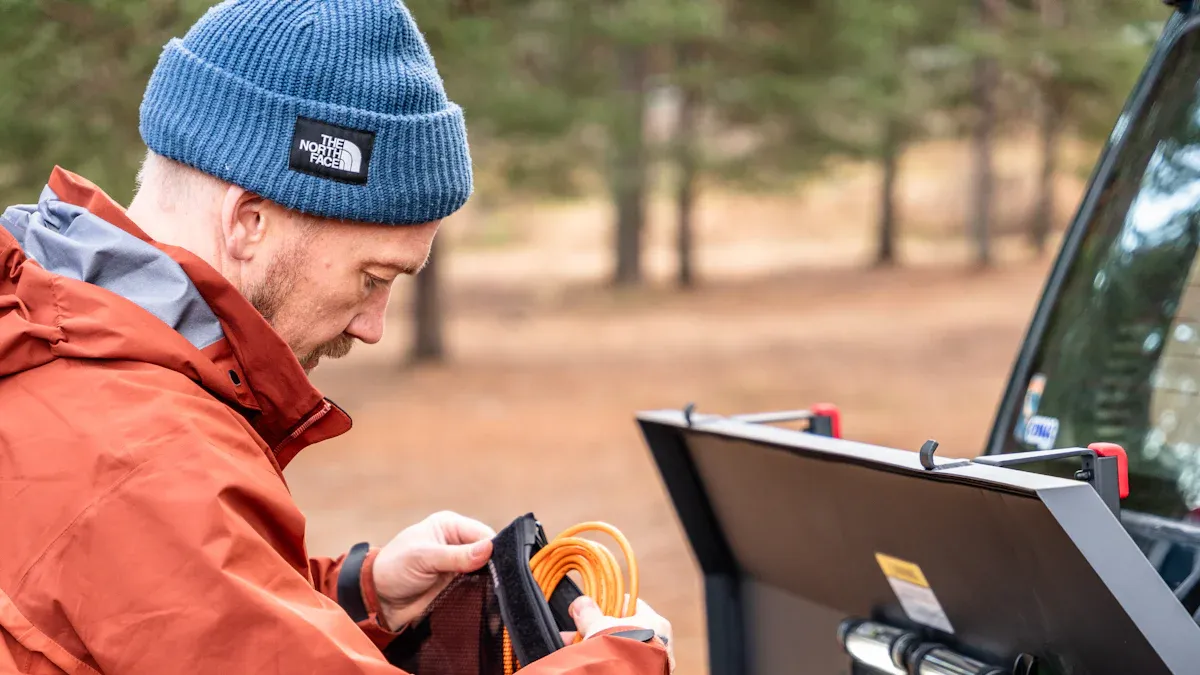
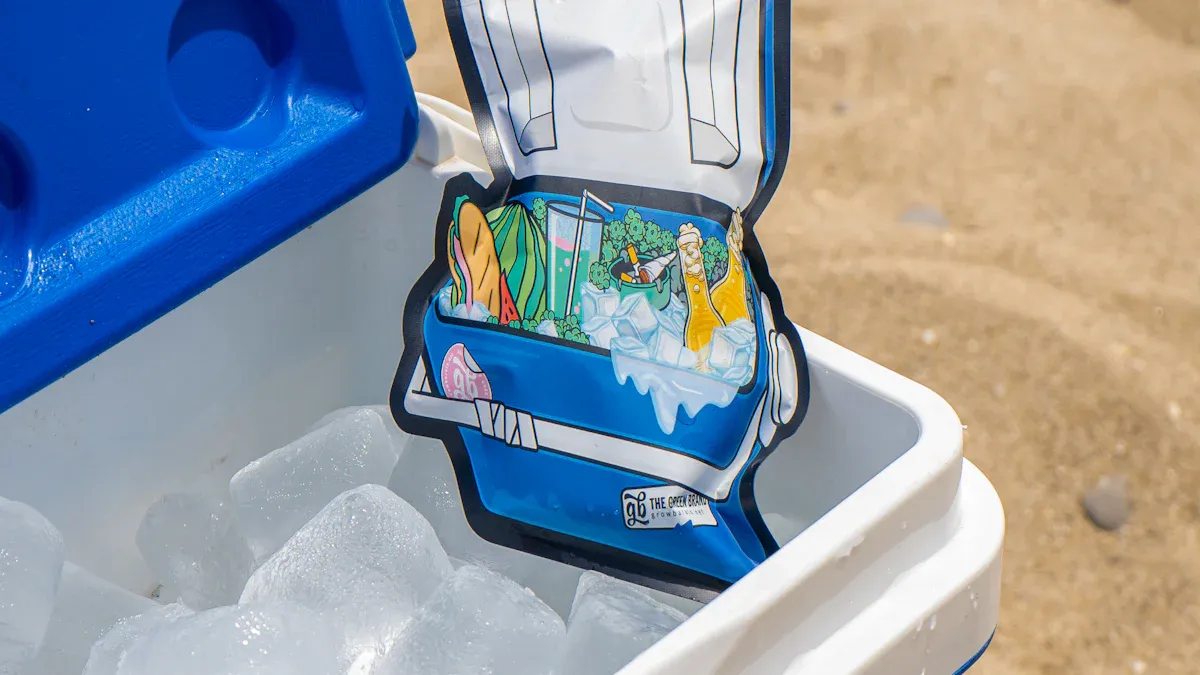
Choosing the right cooler makes a big difference on your outdoor adventures. You want a large ice chest cooler that fits your needs. Think about your trip duration, group size, and even the weather. Outdoor enthusiasts know that choosing the right size cooler means your food and drinks stay cold longer. A good cooler balances insulation, ice retention, and durability. When you look for a large ice chest cooler, focus on features that match your plans and help you stay comfortable on the go.
Key Takeaways
- Choose a cooler size based on your trip length and group size to keep food and drinks cold longer.
- Look for thick insulation, airtight seals, and strong latches to maximize ice retention and durability.
- Use a 2:1 ice-to-food ratio and pack your cooler full to keep items cold for days.
- Pick coolers with wheels or sturdy handles to make carrying heavy loads easier on rough terrain.
- Consider special features like bear resistance, dividers, and drain plugs to improve safety and convenience.
Assessing Your Outdoor Trip Needs for a Large Ice Chest Cooler
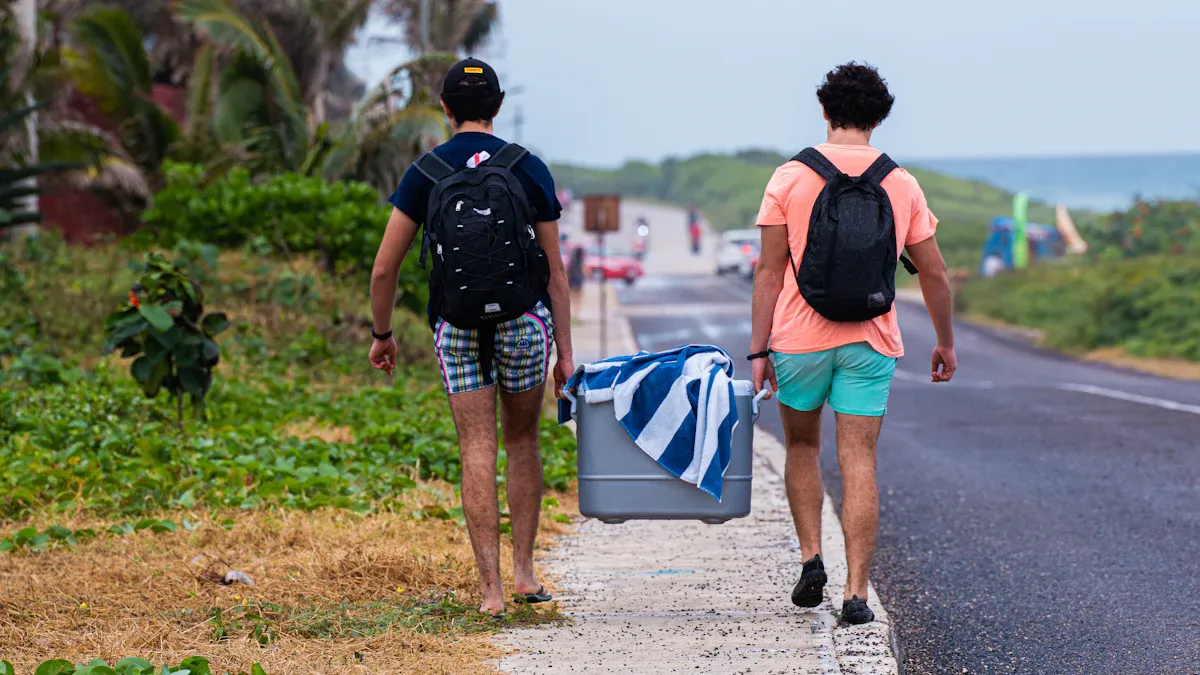
Trip Duration and Group Size
When you plan an outdoor adventure, trip length and group size matter a lot. If you go on a quick overnight trip with a friend, a small cooler might work. For a family or a group heading out for a multi-day camp out, you need a much larger cooler. The bigger your group and the longer your trip, the more space you need for food and drinks. Most people find that a 20-30 quart cooler fits a small group for a day. If you travel with a big group or stay out for several days, you may need a cooler in the 50-120 quart range. This helps keep everything cold and safe to eat.
Here’s a quick look at how different trips affect your cooler choice:
| Trip Type | Cooler Size/Type Needed | Key Needs and Differences |
|---|---|---|
| Car Camping | Large hard-sided cooler (45-60+ quarts) | Main food storage, strong ice retention, holds enough for several days. |
| Extended Multi-day Camping | Very large hard-sided cooler (60+ quarts) | Needs to keep ice for 5+ days, big enough for lots of food and drinks, wheels help with moving it. |
| Family Camping Outings | Large cooler (45-90 quarts) | Feeds more people, stores multiple meals, wheels make it easier to move. |
Food and Drink Storage Requirements
Think about what you want to eat and drink. For each person, you should plan about 1.7 pounds of food per day. If you go for a week, that’s almost 12 pounds per person. You can pack meals in resealable bags to save space and keep things organized. For short trips, a single hard-sided cooler can hold all your food and drinks. On longer trips, you might need extra space for snacks, drinks, and even ice packs. If you want to keep food safe from animals, a bear-resistant cooler is a smart choice. Always match your cooler size to the specific needs of your trip.
Considering Climate and Weather
Weather can change how well your cooler works. Hot days and direct sunlight make ice melt faster. Cooler color also matters. White coolers reflect sunlight and keep ice longer. Black coolers get hotter and lose ice faster. For example:
- In direct sun, a white cooler can keep ice for about 7 days.
- A blue cooler lasts about 6 days.
- A black cooler holds ice for only 5 days.
- Black cooler lids can get much hotter than white ones.
If you camp in the shade or on cloudy days, cooler color matters less. For sunny trips, pick a white or light-colored cooler to help your ice last longer. Always think about the weather when choosing the right cooler for your adventure.
Choosing Cooler Size and Capacity
Estimating Space: Quart and Can Measurements
When you start choosing the right size cooler, you need to know how much space you really get. Cooler capacities are measured in quarts, but it helps to think about how many cans or food items you can fit inside. For example, a 45-quart cooler can hold up to 58 cans if you pack it full, or about 29 cans if you want the best ice retention. Here’s a quick table to help you see how quart size matches up with real-world use:
| Quart Size Range | Typical Use Case | Approximate Can Capacity (12 oz cans) | Notes on Volume and Practical Storage |
|---|---|---|---|
| 20-30 quarts | Solo adventurers or small groups | ~32 cans (e.g., 25-quart cooler) | 1 quart = 1/4 gallon; packaging affects usable space |
| 40-100 quarts | Larger groups, longer trips | 45-quart cooler holds up to 58 cans | More space for ice means better cooling |
Large ice chest coolers, like those in the 75-125 quart range, give you plenty of room for family trips or group outings. When choosing the right cooler size, always check the interior dimensions and weight to make sure it fits your needs.
Ice-to-Content Ratio for Maximum Efficiency
You want your food and drinks to stay cold as long as possible. The secret is the ice-to-content ratio. Most cooler experts recommend a 2:1 ratio—twice as much ice as food or drinks by volume. This creates a cold reservoir that keeps everything chilled. Block ice melts slower than cubes, so use a mix of both for the best results. Fill empty spaces with small ice cubes or frozen bottles to keep warm air out. If you follow this tip, your cooler will keep things cold for days, even on longer trips.
Tip: Always pack your cooler full. Less empty space means less warm air sneaking in and melting your ice.
Matching Capacity to Trip Type
Choosing the right cooler size depends on your adventure. For a solo day trip, a small 10-20 quart cooler works well. Weekend camping or fishing with friends? Go for a medium 20-50 quart cooler. If you plan a big family outing or a multi-day trip, you’ll need a large or extra-large cooler—think 50 quarts or more. Bigger coolers hold more ice and keep things cold longer, but they can be heavy. Look for features like wheels or sturdy handles to help with transport. When choosing the right size cooler, always think about how many people you’re packing for and how long you’ll be out.
Insulation and Ice Retention: What Matters Most
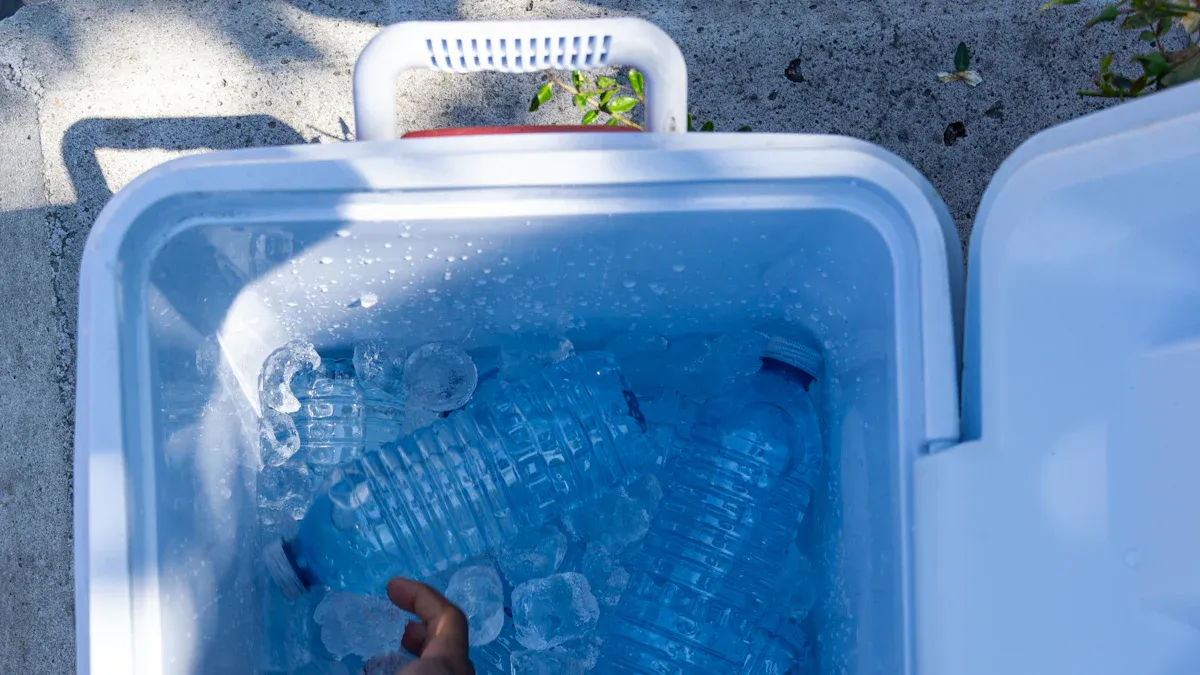
When you pick a large ice chest cooler for your outdoor trip, insulation and ice retention matter more than anything else. You want your food and drinks to stay cold, even on the hottest days. Let’s break down what makes a hard cooler great at keeping cold and how you can spot the best features.
Insulation Thickness and Materials
The secret to a hard cooler’s performance starts with what’s inside the walls. Materials like foam or air-filled plastics work well because they slow down heat. Thick plastic walls filled with high-density foam create a strong barrier that keeps the cold in and the heat out. When you see a hard cooler with 2 to 3 inches of foam insulation in the lid, sides, and bottom, you know it’s built for serious insulation and ice retention.
Some brands, like Engel, use rotomolded construction with two full inches of insulation everywhere—even the lid. This design, paired with airtight silicone gaskets, can keep ice for up to 10 days. Closed-cell spray foam and expanded polystyrene (EPS) foam are top choices for insulation. The thicker the insulation, the longer your ice lasts. Rotomolded bodies also help by creating a seamless shell that blocks heat from sneaking in.
Here’s what you should look for:
- Closed-cell spray foam or EPS foam in the walls and lid
- At least 2 inches of insulation for maximum ice retention
- Rotomolded construction for a tough, seamless body
- Thick insulated lids that match the walls
The ice inside your hard cooler acts like a cold battery. It absorbs heat and keeps everything chilled for days.
Lid Seals and Closure Quality
A hard cooler can have thick walls, but if the lid doesn’t seal tight, cold air escapes fast. You want a lid that closes snugly and stays shut. Look for silicone or freezer-style gaskets set into the lid. These gaskets create an airtight seal, trapping cold air inside and blocking warm air from getting in.
Many top coolers use rubber T-latches or heavy-duty latches made from weather-resistant materials. These latches keep the lid closed, even if you bump or drop the cooler. Some coolers, like the Dometic Patrol 20, use deep-freeze lid seals and rubber latches that stand up to water, cold, and chemicals. Leak-proof drains and thick insulation work with the seal to keep your cooler cold longer.
Tip: Check and clean the lid seal often. A clean, well-lubricated seal keeps your hard cooler working at its best.
Here’s a quick checklist for lid and closure quality:
- Silicone or freezer-style gaskets for airtight sealing
- Rugged rubber latches that hold the lid tight
- Leak-proof drain plugs
- Regular maintenance for seals and latches
Ice Retention Ratings and Real-World Performance
You might wonder how long a hard cooler can really keep ice. Brands test their coolers in labs, but real-world results matter most. Most large hard coolers promise ice retention from 4 to 10 days, depending on how you pack them and the outside temperature.
Check out this table to see how different coolers stack up:
| Cooler Brand/Model | Insulation Type / Features | Ice Retention Duration | Notes on Real-World Performance |
|---|---|---|---|
| Yeti Tundra 45 / Roadie 48 | Rotomolded, thick walls, airtight gasket | 5-10 days | Premium build, confirmed by real-world tests |
| Pelican Elite 50 | Injection-molded, thick walls, latches | Up to 10 days | Heavy-duty, lifetime warranty, matches lab and field tests |
| KUER 45-Quart Cooler | Rotomolded, thick foam, airtight seal | 5-7 days | Rugged design, real-world tests confirm performance |
| RTIC 52 Ultra-Light | Rotomolded, closed-cell foam | Up to 7 days | High performance at lower price, validated in use |
| Coleman Xtreme 5-Day | Injection-molded, foam insulation | Up to 5 days | Moderate retention, suitable for shorter trips |
| Igloo BMX 52 Quart | Blow-molded, extra-thick foam | 4-5 days | Affordable, good for casual use |
| Engel | Rotomolded, airtight gaskets | Not specified | Known for airtight seals, strong ice retention in tests |
You can also see how the maximum ice retention compares across brands:
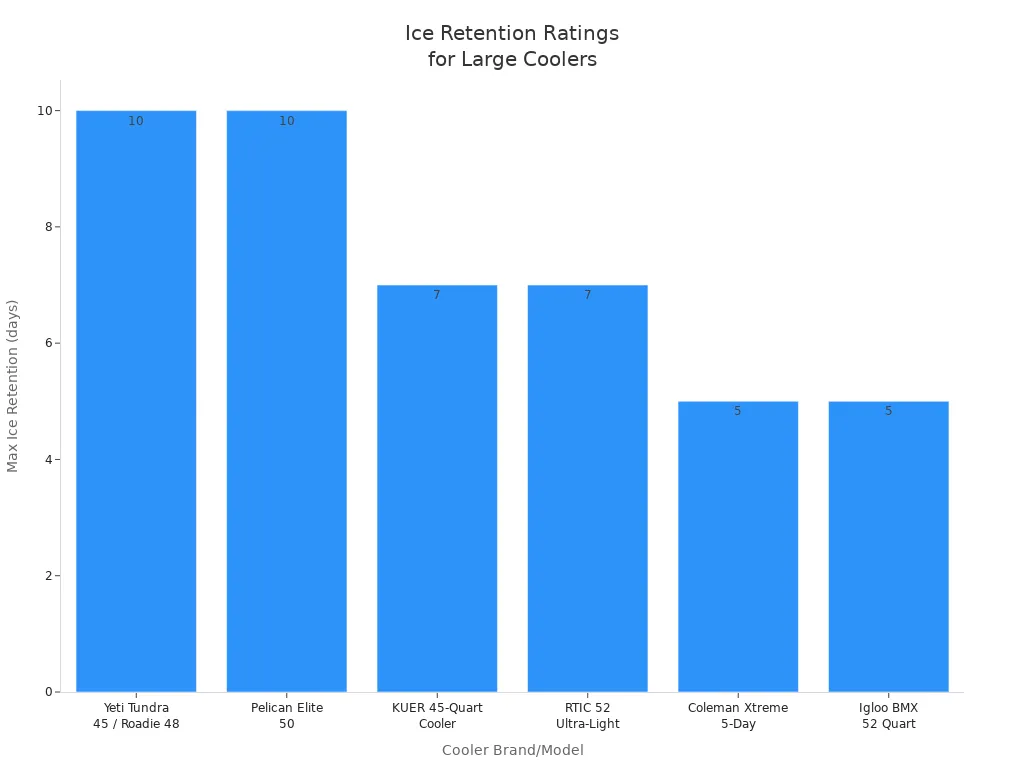
Rotomolded hard coolers usually lead the pack for insulation and ice retention. Premium models like Yeti and Pelican can keep ice for up to 10 days. KUER and RTIC also deliver strong ice retention performance, making them great choices for long trips. Injection-molded and blow-molded coolers work well for shorter adventures.
When you choose a large ice chest cooler, focus on insulation thickness, lid seals, and real-world ice retention. These features make all the difference in keeping cold for your whole trip.
Durability and Build Quality in a Large Ice Chest Cooler
When you pick a hard cooler for your next adventure, you want it to last. Durability matters, especially if you plan to use your large ice chest cooler in tough outdoor settings. Let’s look at what makes a hard cooler strong and reliable.
Rotomolded vs. Injection-Molded Construction
You might wonder why some hard coolers cost more than others. The answer often comes down to how they’re made. Rotomolded hard coolers use a single-piece, seamless design. This makes them tough and less likely to crack. Injection-molded hard coolers have two shells joined together, which can create weak spots. Here’s a quick comparison:
| Feature | Rotomolded Construction | Injection Molded Construction |
|---|---|---|
| Wall Thickness | Thick walls (2–3 inches) | Thinner insulation walls |
| Ice Retention | Superior, typically 7 to 10 days | Shorter, about 1 to 3 days |
| Construction | Single-piece, seamless | Dual-shell, two-piece |
| Durability | Highly impact-resistant, less prone to cracking | Adequate for casual use, more susceptible to damage |
| Handles & Hinges | Reinforced, less likely to loosen | May loosen over time due to two-piece design |
| Weight & Cost | Heavier and more expensive upfront | Lighter and more affordable |
| Ideal Use | Extended trips, rugged environments | Short trips, casual use |
If you want a hard cooler that stands up to drops, bumps, and rough handling, rotomolded is the way to go.
Latches, Hinges, and Handles
The small parts on your hard cooler can make a big difference. You want latches, hinges, and handles that hold up over time. Here’s what you should look for:
- Rotomolded hard coolers from brands like Yeti and Pelican use strong, reinforced joints. This helps prevent cracking and breaking.
- Stainless steel hardware resists rust, which is great for fishing or marine trips.
- Telescoping handles on wheeled models give you better grip and comfort.
- Marine-grade rope handles with textured grips help you carry a loaded hard cooler without hurting your hands.
- Heavy-duty, UV-resistant latches keep the lid tight and secure.
- Thick polypropylene walls and leak-proof gaskets stop leaks and cracks.
Tip: Always check the handles and latches before your trip. A quick inspection can save you trouble later.
Wheels and Ruggedness for Outdoor Use
Moving a loaded hard cooler can be tough, especially on sand or gravel. Good wheels and sturdy handles make a huge difference. Here’s what helps:
- Large, rugged wheels roll over dirt, sand, and gravel with ease.
- Sturdy tow handles let you pull or push your hard cooler without bending over.
- Rotomolded bodies and thick insulation protect your hard cooler from drops and bumps.
- Comfortable handles make it easier to move a heavy hard cooler, even when it’s full.
- Some hard coolers add features like cup holders and drain plugs for extra convenience.
- Durable designs mean you won’t need to replace your hard cooler often, even with heavy use.
When you choose a hard cooler, remember that durability matters. A well-built hard cooler keeps your food cold and stands up to whatever your adventure throws at it.
Portability Features in a Large Cooler
Weight and Carrying Options
When you pick a hard cooler for your trip, weight matters a lot. Some large hard coolers can feel heavy even before you add ice or food. Take a look at this table to see how much some popular models weigh when empty:
| Cooler Model | Capacity (Quarts) | Weight (Empty) |
|---|---|---|
| Coleman 316 Series | 70 | ~11 lb. 6 oz. |
| XSpec 60 QT | 57 | ~31 lb. 1 oz. |
| YETI Roadie 48 | 45 | ~28 lb. 5 oz. |
You can see that a hard cooler can weigh as much as a small child! That’s why carrying options make a big difference. Some hard coolers have molded side handles, while others use rope handles with grips. A few even come with backpack straps, so you can carry them hands-free. Retractable handles help you pull the cooler instead of lifting it. These features make portability and transportation much easier, especially if you have to walk a long way.
Wheels for Rough Terrain and Sand
Wheels can turn a heavy hard cooler into something you can move with ease. If you plan to roll your hard cooler over rocks, gravel, or sand, look for models with large, tough wheels. Some coolers use a single piece of strong plastic for their wheels, so they don’t get stuck or break on rough ground. Igloo coolers, for example, have oversized wheels and legs that keep the cooler off the ground. This design helps you move your hard cooler across sand or bumpy trails without much trouble. YETI’s Roadie 48 has a telescoping handle and a smaller footprint, making it easier to tow over obstacles.
Tip: If you often camp on sand or rocky ground, choose a hard cooler with big, sturdy wheels for the best portability and transportation.
Transporting Large Coolers Easily
Moving a large hard cooler doesn’t have to be a struggle. Here are some simple ways to make it easier:
- Keep your hard cooler inside the vehicle cabin, not in the trunk or on the roof, to avoid extra heat.
- Shade your hard cooler at the campsite with a table or cover to keep things cold.
- Use locks or bungee cords to secure your hard cooler and keep animals out.
- Pack your hard cooler with ice packs along the bottom and sides for better insulation.
- Try not to open your hard cooler too often, so the cold stays inside.
Choosing the right hard cooler with smart features makes portability and transportation simple, even on tough trips.
Special Features to Look for in a Large Ice Chest Cooler
Bear Resistance and Security
When you camp in bear country, you want your food and gear to stay safe. Some coolers come with bear-resistant features. The Interagency Grizzly Bear Committee (IGBC) tests and certifies coolers for bear resistance. To earn this certification, a cooler must survive a real grizzly bear trying to break in for 60 minutes. You can look for the IGBC logo or certification number on your cooler. This means the cooler meets tough standards and helps keep wildlife out. Remember, you still need to lock the cooler to keep it secure. Many parks and public lands trust IGBC-certified coolers, so you can feel confident when you bring one on your trip.
Dividers, Baskets, and Organization
You can make your large ice chest cooler even more useful with a few smart accessories. Dividers split the inside into sections. You can keep drinks on one side and food on the other. Some dividers double as cutting boards, which saves space. Dry rack baskets help you keep snacks or bread above the ice, so they stay dry. Wire baskets work better than plastic trays because they do not break easily and keep food out of melting ice. These additional features help you find what you need fast and keep your cooler neat. You can also use stackable baskets to use all the space inside. Built-in handles make it easy to lift and move things around.
Tip: Using dividers and baskets helps you keep food cold longer and makes packing for your trip much easier.
Drain Plugs and Useful Accessories
Drain plugs are small but important. They let you empty melted ice without tipping the cooler. This keeps your food dry and makes cleaning up simple. Some coolers offer extra accessories like reusable ice packs, cup holders, or even wheel kits. These additional features save you time and make your trip more comfortable. You can pick and choose the accessories that fit your needs best. When you look for a cooler, check which extra options are available. The right accessories can turn a good cooler into a great one.
Budget Considerations When Buying a Cooler
Value vs. Premium Large Ice Chest Coolers
When you shop for a large ice chest, you will notice a big price range. Some coolers cost around $50, while others, like YETI, can cost $300 or more. Why do premium coolers cost so much? The answer is in the materials and build. Premium brands use thick insulation, strong rotomolded bodies, and heavy-duty latches. These features help the cooler keep ice for up to a week or longer. Cheaper coolers use thinner walls and lighter materials. They work well for a weekend, but you may need to replace them sooner. If you want a cooler that lasts for years and keeps things cold on long trips, a premium model is worth the investment.
Frequency of Use and Investment
Think about how often you go outdoors. If you camp or fish only a few times a year, a value cooler might be enough. You can save money and still keep your food cold for a couple of days. If you spend more than 20 days a year outside, a premium cooler makes sense. You get better ice retention, stronger parts, and less worry about damage. Over time, you save money because you do not need to buy a new cooler every year. Premium coolers also come with extra features like bear resistance and reinforced corners, which help in tough conditions.
Tip: If you use your cooler a lot, spending more up front can save you money in the long run.
KUER and Other Recommended Brands
You have many choices when picking a large ice chest. Here is a quick look at how top brands compare:
| Brand & Model | Capacity (QT) | Ice Retention | Portability | Special Features |
|---|---|---|---|---|
| KUER Rotomolded Cooler | 52 | 5-7 days | Heavy-duty handles | Rotomolded, rugged build |
| YETI Tundra 45 | 45 | 4-5 days | Heavy-duty handles | Bear-resistant, durable |
| RTIC 52 QT Ultra-Light | 52 | 4 days | Wheels, light | No-sweat exterior, easy drain |
| Coleman Xtreme 70 | 70 | 5 days | Standard handles | Affordable, large capacity |
| Igloo MaxCold 70 | 70 | 5 days | Standard handles | UV inhibitors, budget-friendly |
| Pelican 45QW Elite | 45 | 6 days | Wheels, sturdy | Lifetime warranty, secure latches |
| ORCA Classic Cooler | 58 | 6 days | Standard handles | Thick insulation, USA-made |
| Engel UltraLite 48 | 48 | 4 days | Lightweight | Drybox function, easy carry |
| RovR RollR 60 | 60 | 7 days | All-terrain wheels | Bike attachment, dry bin |
| Lifetime High Performance | 55 | 5 days | Standard handles | Affordable, sturdy |
| Blue Coolers Ice Vault 60 | 60 | 6 days | Standard handles | Value, large capacity |
You can see KUER stands out with its tough rotomolded build and strong ice retention. Some brands, like RovR and Pelican, offer wheels for easy moving. Others, like Coleman and Igloo, focus on value and large size. Here is a chart that shows how long each brand keeps ice:
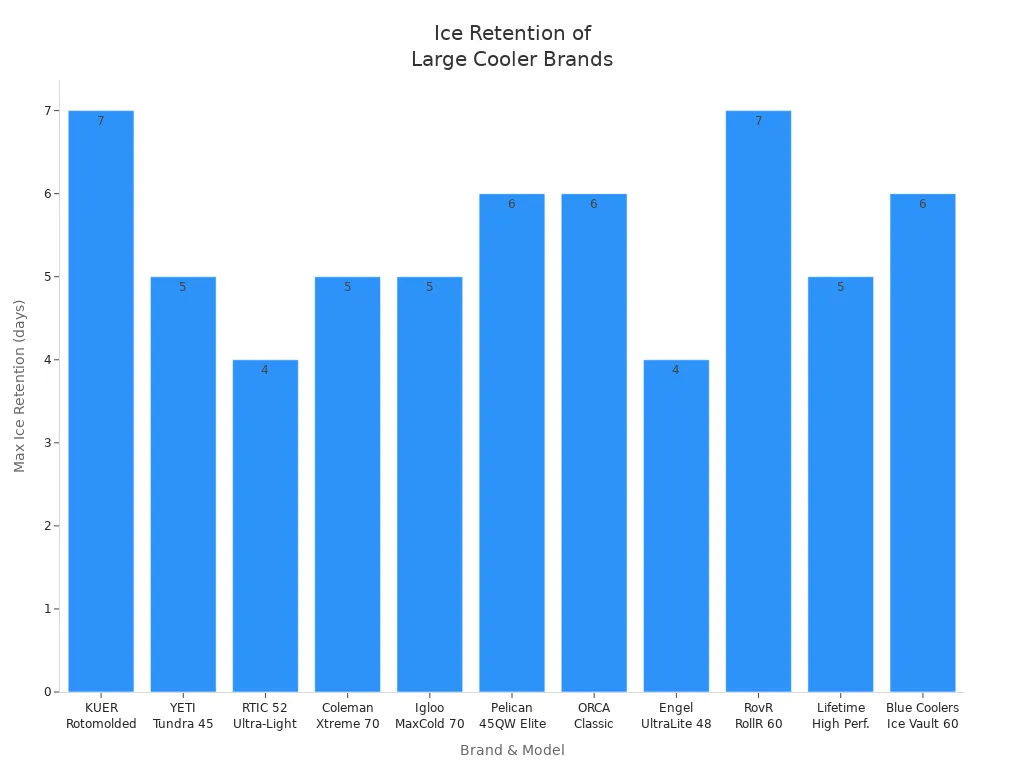
When you compare brands, look at ice retention, durability, and how easy it is to carry. KUER gives you a balance of performance and value, making it a smart pick for many outdoor trips.
Quick Cooler Recommendations by Outdoor Activity
Camping Trips
When you plan a camping weekend, you want a cooler for camping that keeps your food safe and cold. Outdoor experts often call the Pelican Elite Coolers the best camping cooler for most trips. These camping coolers stand out because they last, even in tough conditions. You get strong rotomolded construction, thick insulation, and secure latches. The Pelican 45QT Elite Wheeled Cooler is a top pick for a weekend camping trip. It holds ice for 7-10 days, so you do not have to worry about your food spoiling. The wheels and sturdy handles make it easy to move, even when full. If you camp with a big group, the 80QT model gives you more space and the same great features.
Tip: Look for a cooler for camping with bear resistance if you visit parks with wildlife. Pelican coolers meet this need and give you peace of mind.
Here are the top recommendations for camping coolers:
- Pelican 45QT Elite Wheeled Cooler (best camping cooler for most campers)
- Pelican 80QT Elite Wheeled Cooler (for longer trips or larger groups)
Fishing Adventures
Fishing trips need a cooler for camping that can handle long days on the water. You want your catch and drinks to stay cold all weekend. The best camping cooler for fishing has great ice retention, a size that fits your boat, and strong hardware. Many anglers choose coolers around 65 quarts. These fit well on most boats and hold enough for a weekend getaway. Look for fishing coolers with non-slip feet, tie-down points, and corrosion-resistant hardware. Flat lids work as seats or cutting boards, which adds value.
Some top recommendations for fishing coolers:
- YETI Tundra 65 (excellent ice retention, strong build)
- RTIC 65-QT (affordable, durable, easy to clean)
- Cabela’s Polar Cap 60 (marine-grade, fits most boats)
Note: Pre-chill your cooler for camping with frozen bottles before your trip. This helps keep everything cold longer.
Hunting Excursions
Hunting trips often last several days, so you need a large cooler for camping that holds ice and meat all week. Hunters look for coolers around 100 quarts with tough, leakproof designs. Durability and ice retention matter most. Many hunters trust Yeti, but other brands like Lifetime and Igloo also perform well. You want a cooler that fits under your truck bed cover and stands up to rough use. Here’s a table to help you compare the best camping cooler options for hunting:
| Cooler Model | Ice Retention (Days) | Durability Features |
|---|---|---|
| Lifetime 55 Quart High-Performance Cooler | Up to 7 | Leakproof, durable, great for hunting |
| Igloo Quantum | Up to 7.75 | Robust lid, strong build |
| Igloo BMX | Up to 7.5 | Durable, mid-range price |
| Lifetime Coolers (various sizes) | Up to 9 | Leakproof, highly durable |
| Yeti (popular among hunters) | Approx. 7 | Rugged, trusted for hunting trips |
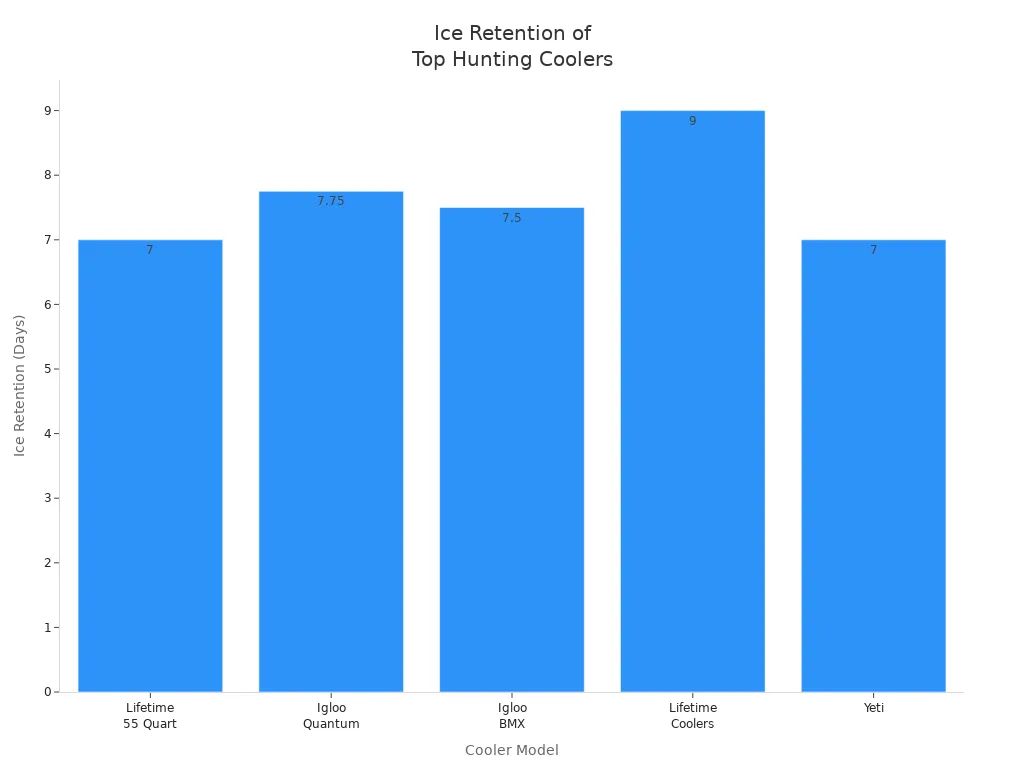
You can trust these coolers to keep your game and food cold all weekend. For hunting, always pick a cooler for camping that matches your trip length and storage needs.
BBQs and Picnics
Planning a BBQ or picnic means you want a cooler that is easy to carry, keeps drinks cold, and has enough space for everyone’s favorites. You do not want to lug around a heavy box just for a short outing. For these fun days, you should look for a cooler that balances portability and capacity. Here’s a quick table to help you compare some top recommendations for BBQs and picnics:
| Cooler Model | Capacity & Portability | Ice Retention | Durability & Additional Features |
|---|---|---|---|
| Yeti Tundra 75 | Large capacity; best overall cooler | Excellent (multi-day) | Highly durable; premium build quality |
| Coleman Chiller 48-Qt | Holds 76 cans; light (~8 lbs empty); portable for 1-2 people | 3 days even at 90°F | Sturdy enough to double as a seat; built-in drain; budget-friendly |
| Yeti Hopper M30 (soft) | Large capacity; highly portable with padded shoulder strap | 15-20 hours | Extremely durable; airtight zipper closure; soft cooler ideal for day trips and picnics |
You can see that the Yeti Tundra 75 stands out if you want the best camping cooler for a big group. The Coleman Chiller 48-Qt is great for a small family or a couple of friends. The Yeti Hopper M30 works well for a quick picnic or a short weekend BBQ. If you plan to spend the whole weekend outside, you might want a hard cooler with longer ice retention. For a single afternoon, a soft cooler is easy to carry and keeps your drinks cold until sunset.
Tip: Pack your cooler with a mix of ice and cold drinks before you leave. This helps everything stay cold, even on a hot day.
Large Group or Family Trips
When you travel with a big group or your whole family, you need a cooler that can handle lots of food and drinks. Large ice chest coolers with capacities between 75 and 125 quarts work best for these trips. You get enough space for everyone, and your ice lasts longer.
- The Mammoth Ranger 125 is a smart pick for long weekends or group adventures. It gives you plenty of room and keeps ice for days.
- If your group is very large or you plan an extended trip, look for expedition coolers over 125 quarts. Just remember, these coolers can get heavy—sometimes up to 350-375 pounds when full.
- Bigger coolers keep ice longer because they hold more ice and have a better volume-to-surface-area ratio.
- Before you buy, check if the cooler fits in your vehicle. Handles and wheels make moving these big coolers much easier.
- High-performance coolers, like Mammoth models, use thick insulation and tough construction. They work well for serious outdoor adventures.
For groups of 6 or more and trips lasting three or more days, YETI recommends coolers starting at 110 quarts. Models like the YETI Tundra 110, 125, 160, 210, and 250 are all good choices. If you want the best camping cooler for a weekend with four to six people, a 65-105 quart cooler is usually enough. Using two coolers—one for food and one for drinks—helps keep everything colder. The Tundra 105 is deep and saves space in your car.
Pro tip: Always use a 2:1 ice-to-contents ratio for the best results on your next weekend adventure.
Choosing the right large ice chest cooler makes your outdoor trips easier and more fun. Remember these tips:
- Pick the right size—35 to 55 quarts for small groups, 65 to 75 quarts for family trips, and 100+ quarts for big adventures.
- Look for strong insulation and features like wheels or handles.
- Fill your cooler full and use block ice for the best ice retention.
- Keep your cooler in the shade and open it only when needed.
Match your cooler’s size, insulation, and features to your trip. Balance what you need with your budget for the best experience every time.
FAQ
How do I clean my large ice chest cooler after a trip?
You can wash your cooler with mild soap and warm water. Use a soft brush for tough spots. Rinse well and let it air dry with the lid open. This helps prevent odors and keeps your cooler fresh for next time.
What is the best way to pack a cooler for maximum ice retention?
Start with a pre-chilled cooler. Use a 2:1 ice-to-contents ratio. Place block ice at the bottom, then add your food and drinks. Fill gaps with smaller ice or frozen bottles. Keep the lid closed as much as possible.
Can I use dry ice in my large cooler?
Yes, you can use dry ice in many rotomolded coolers. Always wear gloves when handling dry ice. Make sure your cooler is dry ice compatible. Leave a small gap for gas to escape. Never seal the cooler completely with dry ice inside.
How do I keep bears and animals out of my cooler?
Choose a bear-resistant cooler with IGBC certification. Always lock your cooler with approved locks. Store it away from your tent or campsite. Follow local wildlife safety rules to keep your food and gear safe.
What size cooler should I get for a weekend family trip?
For a family of four on a weekend trip, a 50-75 quart cooler usually works well. This size gives you enough space for meals, drinks, and ice. If you pack extra snacks or drinks, consider a second smaller cooler.



